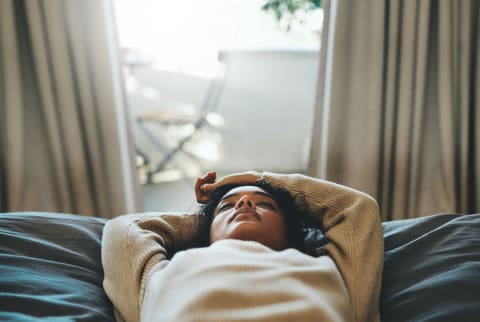Why White Noise Doesn't Actually Help You Sleep + What To Listen To Instead


When you're trying to fall asleep, any stray sound can quickly amplify. Noise machines have become popular sleep tools for masking the squeak of a floorboard in the next room or the honk of cars outside. While we often group all of their steady, fan-like tones together as "white noise," sound and music experts explain that there are actually many different "colors" of noise these machines emit—and white noise is probably the worst for sleep. Here's why, and what color sounds you should seek for your slumber instead.
Advertisement
What is white noise?
Sound theory is super mathematical and technical, but in its most basic form, sound is a combination of wavelengths that have different frequencies, or speeds of vibration. "Noise is a selection of individual frequencies playing in a random distribution," explains Greg McAllister, a senior sound experience manager at Sonos who helps craft the company's sleep stations for Sonos Radio. "The different flavors of noise are how that frequency distribution is weighted across the range."
When all of these different frequencies are weighted equally, you get true white noise. Stanford acoustics researcher and neuroscience adviser at Spiritune Daniel Bowling, Ph.D., explains that this equal weighting of frequencies is very unnatural. That is, it sounds more like the static whir of a machine than anything you'd hear if you stepped outside into a forest or beach. (In nature, higher frequencies are not represented as often.)
"White noise is like television static. If you make that really loud, it's going to be really annoying," Bowling tells mbg. "The high-frequency content will grab your attention, heighten your arousal, and make you anxious."
So he notes that while white noise is often discussed as a gold standard for sleep, it's actually the last thing you'd want to turn on to relax at bedtime.
Which color of noise is better for sleep.
Other colors of noise have different distributions of low and high frequencies—unlike white noise, which represents all frequencies evenly. Pink noise is more weighted toward low frequencies, and it tends to be more appealing to our ears. Compared to white noise, McAllister notes that pink noise sounds smoother and warmer. Instead of the high-pitched static of television, it's more akin to the deep whir of waves lapping on a beach.
"Brown noise takes that even a step further so it's even more heavily weighted toward the low frequencies. That can sound more like a rumble or a thunderstorm," he notes. Since these sounds more closely correlate to what we'd hear out in nature, McAllister says that it makes sense we'd intuitively find them comforting.
Pink noise, in particular, has been shown to be deeply relaxing in lab studies. When we're asleep, our brains are still processing some of the noises of our surrounding environment—our brainwaves can actually sync up with the frequency of the sounds we're hearing1. Some research has found that the deep, low frequencies of pink noise have been shown to ease our brains2 into slow-wave states where recovery and memory consolidation can occur. This means that beyond masking annoying stimulating sounds, pink noise might actually go a step further to improve our overall sleep quality3 and enhance our memory4 in the process.
Advertisement
The bottom line.
Most white noise machines on the market actually play a spectrum of different colors of noise. To achieve deeper sleep, you'll want to choose one that falls more into the pink spectrum of noise and sounds like waves on the beach.

Emma Loewe is the Sustainability and Health Director at mindbodygreen and the author of Return to Nature: The New Science of How Natural Landscapes Restore Us. She is also the co-author of The Spirit Almanac: A Modern Guide To Ancient Self Care, which she wrote alongside Lindsay Kellner.
Emma received her B.A. in Environmental Science & Policy with a specialty in environmental communications from Duke University. In addition to penning over 1,000 mbg articles on topics from the water crisis in California to the rise of urban beekeeping, her work has appeared on Grist, Bloomberg News, Bustle, and Forbes. She's spoken about the intersection of self-care and sustainability on podcasts and live events alongside environmental thought leaders like Marci Zaroff, Gay Browne, and Summer Rayne Oakes.

